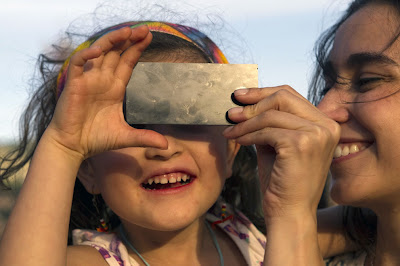Transits – What are they?
Under such circumstances, an annular eclipse of the Sun takes place, as was witnessed on 15 January 2010 from many parts of the world including India. We then see a bright ring around the Sun with Moon positioned inside the disc of the Sun. However, when the inner planets Mercury or Venus come in between the Sun and the Earth, it is called a transit. Their angular sizes being much smaller than that of the Moon, we only see a black dot (rather than a dark circle as during the annular solar eclipse) passing across the disc of the Sun. However, the transit phenomena are rare. Mercury transit takes place some 13 to 14 times in a century. Transits of Venus, however, are even rarer taking place with intervals of over a century. Incidentally, there was no transit of Venus in the entire 20th century!
The Four Contacts
T-Day
A Great Opportunity for Science Communicators
On October 24, 1995, June 11, 1999, and 22 July 2009, we had a rare opportunity of witnessing a Total Solar Eclipse from India, when millions observed and enjoyed one of the most spectacular phenomena of nature. When Moon comes in between the Earth and the Sun, a solar eclipse takes place. Total solar eclipse takes place when the Moon is close enough to the Earth and hence its angular diameter is large enough to cover the disc of the Sun. However, it could happen that the Moon is rather far away from the Earth (and the Earth close enough to the Sun) making the apparent diameter of the Moon smaller than that of the Sun. The Moon then cannot cover the entire disc of the Sun.
Under such circumstances, an annular eclipse of the Sun takes place, as was witnessed on 15 January 2010 from many parts of the world including India. We then see a bright ring around the Sun with Moon positioned inside the disc of the Sun. However, when the inner planets Mercury or Venus come in between the Sun and the Earth, it is called a transit. Their angular sizes being much smaller than that of the Moon, we only see a black dot (rather than a dark circle as during the annular solar eclipse) passing across the disc of the Sun. However, the transit phenomena are rare. Mercury transit takes place some 13 to 14 times in a century. Transits of Venus, however, are even rarer taking place with intervals of over a century. Incidentally, there was no transit of Venus in the entire 20th century!
The Four Contacts
The transit begins with contact I, the instant the planet's disk is externally tangent to the Sun. Shortly after contact I, the planet can be seen as a small notch along the solar limb. The entire disk of the planet is first seen at contact II when the planet is internally tangent to the Sun. Over the course of several hours, the planet slowly traverses the solar disk. At contact III, the planet reaches the opposite limb and once again is internally tangent to the Sun. Finally, the transit ends at contact IV when the planet's limb is externally tangent to the Sun. Contacts I and II define the phase called ingress while contacts III and IV are known as egress. Figure 2 shows the transit paths along with the four contact points for the events of 08 June 2004 and 06 June 2012 respectively.
Transit-day, or the T-day: June 06, 2012 is our date for rendezvous with Venus. The next transit would take place only after a long gap of 105.5 years. What is more, this was an historical event that helped measure the distance of the Earth from the Sun, and consequently of all the planets. This event would offer science communicators a great opportunity to popularise astronomy, and address unscientific beliefs and superstitious at the same time associated with celestial events. As during the Total Solar Eclipses of 1995 and 1999, the annular solar eclipse of 2010, and the last Venus transit of 2004, this would be an event in which students, teachers, general public, and Government / nonGovernment organisations, would be involved. We do hope you would be a part of this
great event.
A Great Opportunity for Science Communicators
In association with leading research institutions in the country, National Council for Science and Technology Communication (NCSTC) and Vigyan Prasar have planned a comprehensive countrywide campaign to make people aware of the phenomena related to astronomy in general and transits in particular. While a transit of Mercury or Venus offersa great opportunity to the scientists to measure the planetary distances from the Sun, it provides a great occasion to science communicators to utilise the spectacular event to communicate the basic scientific aspects related to several astronomical phenomena in particular, and science & technology (S&T) in general to the members of the community.
The main objective of the proposed programme is to utilise the event of Venus Transit fort riggering an interest in S&T especially among children in S&T in generaland in Astronomy in particular. A spate of activities would involve students/teachers/general public and active association / collaboration of Government / non-Government / voluntary organisations.












are saw that.........
ReplyDelete